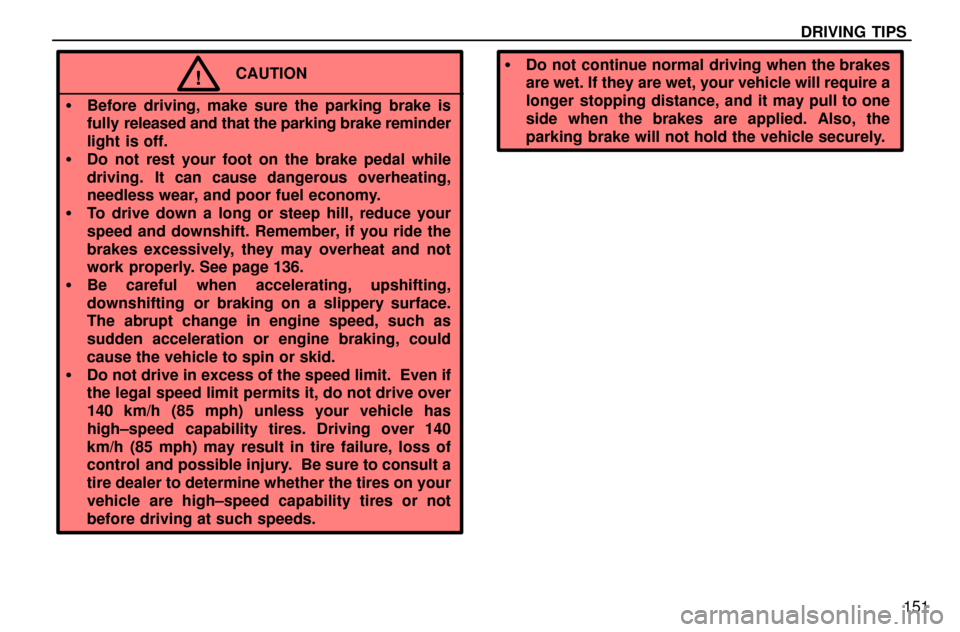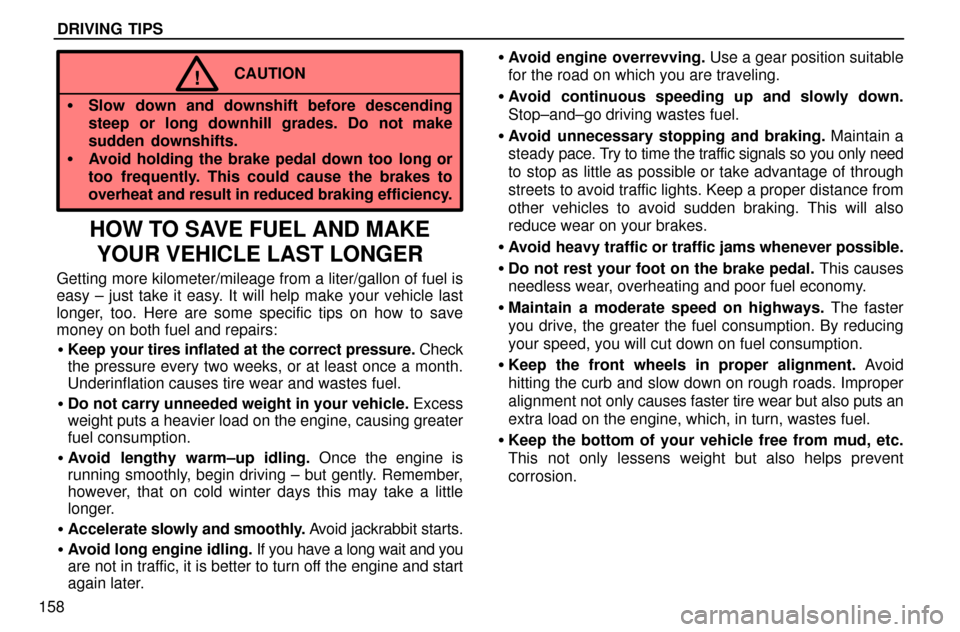Page 3 of 12

DRIVING TIPS
151
CAUTION!
�Before driving, make sure the parking brake is
fully released and that the parking brake reminder
light is off.
�Do not rest your foot on the brake pedal while
driving. It can cause dangerous overheating,
needless wear, and poor fuel economy.
�To drive down a long or steep hill, reduce your
speed and downshift. Remember, if you ride the
brakes excessively, they may overheat and not
work properly. See page 136.
�Be careful when accelerating, upshifting,
downshifting or braking on a slippery surface.
The abrupt change in engine speed, such as
sudden acceleration or engine braking, could
cause the vehicle to spin or skid.
�Do not drive in excess of the speed limit. Even if
the legal speed limit permits it, do not drive over
140 km/h (85 mph) unless your vehicle has
high±speed capability tires. Driving over 140
km/h (85 mph) may result in tire failure, loss of
control and possible injury. Be sure to consult a
tire dealer to determine whether the tires on your
vehicle are high±speed capability tires or not
before driving at such speeds.
�Do not continue normal driving when the brakes
are wet. If they are wet, your vehicle will require a
longer stopping distance, and it may pull to one
side when the brakes are applied. Also, the
parking brake will not hold the vehicle securely.
Page 6 of 12

DRIVING TIPS
154
�Total trailer weight�Tongue load
�The trailer cargo load should be distributed so
that the tongue load is 9 to 11% of the total trailer
weight, not exceeding the maximum of 90 kg (200
lb.).
Tongue load
x 100 = 9 to 11%
Total trailer weight
�Never load the trailer with more weight in the back
than in the front. About 60% of the trailer load
should be in the front half of the trailer and the
remaining 40% in the rear.
Hitches
�If you wish to install a trailer hitch, your Lexus dealer should
be consulted.
�Use only a hitch which is recommended by the hitch
manufacturer and conforms to the total trailer weight
requirement.
�Follow the directions supplied by the hitch manufacturer.
Lubricate the hitch ball with a light coat of grease.
�Lexus recommends removing the trailer hitch whenever
you are not towing a trailer to reduce the possibility of
additional damage caused by the hitch if your vehicle is
struck from behind. After removing the hitch, sel any
mounting holes in the vehicle body to prevent entry of
pollutants such as exhaust fumes, dirt, water, etc.
NOTICE
�Install the trailer hitch using only the position
recommended by your Lexus dealer. Do not
install the trailer hitch on the bumper; this may
cause body damage.
�Do not use axle±mounted hitches as they can
cause damage to the axle housing, wheel
bearings, wheels or tires.
Page 7 of 12

DRIVING TIPS
155
Brakes and safety chains
�Lexus recommends trailers with brakes that conform
to any applicable federal and state/provincial
regulations.
�A safety chain must always be used between the
towing vehicle and the trailer. Leave sufficient slack in
the chain for turns. The chain should cross under the
trailer tongue to prevent the tongue from dropping to
the ground in case it becomes damaged or separated.
For correct safety chain procedures, follow the hitch
or trailer manufacturer's recommendations.
CAUTION!
�If the total trailer weight exceeds 450 kg (1000 lb.),
trailer brakes are required.
�Never tap into your vehicle's hydraulic system as
it will lower its braking effectiveness.
�Never tow a trailer without using a safety chain
securely attached to both the trailer and the
vehicle. If damage occurs to the coupling unit or
hitch ball, there is possible danger of the trailer
wandering over into another lane.
Tires
�Ensure that your vehicle's tires are properly inflated.
Adjust the tire pressure to the recommended cold tire
pressure indicated below:
Tire pressure, kPa (kgf/cm
2 or bar, psi)
Front 220 (2.2, 32)
Rear 220 (2.2, 32)
�The trailer tires should be inflated to the pressure
recommended by the trailer manufacturer in respect to the
total trailer weight.
Trailer lights
�Trailer lights must comply with federal, state/provincial and
local regulations. See your local recreational vehicle dealer
or rental agency for the correct type of wiring and relays for
your trailer. Check for correct operation of the turn signals
and stop lights each time you hitch up. Direct splicing may
damage your vehicle's electrical system and cause a
malfunction of your lights.
Break±in schedule
�Lexus recommends that you do not tow a trailer with a new
vehicle or a vehicle with any new power train component
(engine, transmission, differential, wheel bearing, etc.) for
the first 800 km (500 miles) of driving.
Page 10 of 12

DRIVING TIPS
158
CAUTION!
�Slow down and downshift before descending
steep or long downhill grades. Do not make
sudden downshifts.
�Avoid holding the brake pedal down too long or
too frequently. This could cause the brakes to
overheat and result in reduced braking efficiency.
HOW TO SAVE FUEL AND MAKE
YOUR VEHICLE LAST LONGER
Getting more kilometer/mileage from a liter/gallon of fuel is
easy ± just take it easy. It will help make your vehicle last
longer, too. Here are some specific tips on how to save
money on both fuel and repairs:
�Keep your tires inflated at the correct pressure. Check
the pressure every two weeks, or at least once a month.
Underinflation causes tire wear and wastes fuel.
�Do not carry unneeded weight in your vehicle. Excess
weight puts a heavier load on the engine, causing greater
fuel consumption.
�Avoid lengthy warm±up idling. Once the engine is
running smoothly, begin driving ± but gently. Remember,
however, that on cold winter days this may take a little
longer.
�Accelerate slowly and smoothly. Avoid jackrabbit starts.
�Avoid long engine idling. If you have a long wait and you
are not in traffic, it is better to turn off the engine and start
again later.�Avoid engine overrevving. Use a gear position suitable
for the road on which you are traveling.
�Avoid continuous speeding up and slowly down.
Stop±and±go driving wastes fuel.
�Avoid unnecessary stopping and braking. Maintain a
steady pace. Try to time the traffic signals so you only need
to stop as little as possible or take advantage of through
streets to avoid traffic lights. Keep a proper distance from
other vehicles to avoid sudden braking. This will also
reduce wear on your brakes.
�Avoid heavy traffic or traffic jams whenever possible.
�Do not rest your foot on the brake pedal. This causes
needless wear, overheating and poor fuel economy.
�Maintain a moderate speed on highways. The faster
you drive, the greater the fuel consumption. By reducing
your speed, you will cut down on fuel consumption.
�Keep the front wheels in proper alignment. Avoid
hitting the curb and slow down on rough roads. Improper
alignment not only causes faster tire wear but also puts an
extra load on the engine, which, in turn, wastes fuel.
�Keep the bottom of your vehicle free from mud, etc.
This not only lessens weight but also helps prevent
corrosion.